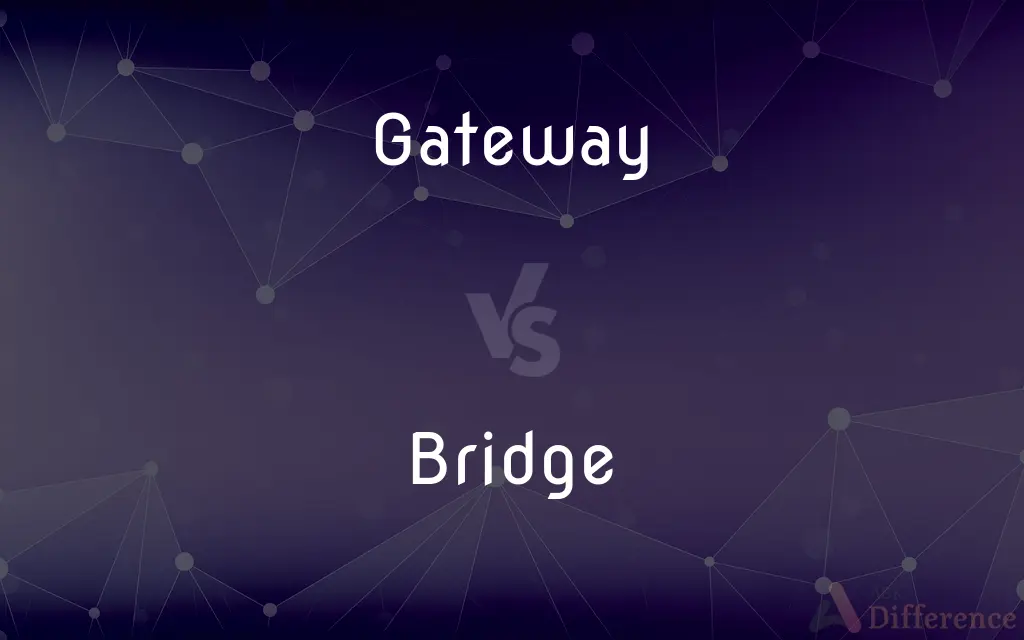Gateway vs. Bridge — What's the Difference?
Edited by Tayyaba Rehman — By Maham Liaqat — Updated on March 21, 2024
A gateway links different networks using various protocols, while a bridge connects segments of the same network, filtering traffic.

Difference Between Gateway and Bridge
Table of Contents
ADVERTISEMENT
Key Differences
A gateway serves as a network point that acts as an entrance to another network, facilitating communication between networks that use different protocols. On the other hand, a bridge operates within a single network to connect two or more network segments, making the network more efficient by managing the flow of traffic.
Gateways are more complex devices that perform protocol conversions to ensure that data packets can move between dissimilar networks, such as between a local area network (LAN) and a wide area network (WAN). Whereas bridges are simpler devices that primarily filter and forward packets between segments of the same network based on MAC addresses, without altering the packets themselves.
While gateways can operate at any layer of the OSI model, depending on the types of protocols they need to translate between, bridges typically operate at the data link layer (Layer 2). This distinction highlights the gateway's role in facilitating broader network connectivity and communication across diverse protocols, compared to the bridge's role in local traffic management.
Gateways often incorporate additional functionalities such as security measures, including firewalls and intrusion detection systems, to protect the networks they connect. In contrast, bridges focus on improving network performance by reducing congestion and segmenting traffic, without the direct responsibility for network security.
The application of gateways is essential for complex network architectures that involve the integration of heterogeneous systems, such as connecting an office network to the internet. Bridges are utilized in simpler scenarios where the goal is to extend the range of a network or to segment it into more manageable parts, enhancing overall network performance without changing the data being transmitted.
ADVERTISEMENT
Comparison Chart
Function
Connects networks using different protocols
Connects segments of the same network
Complexity
More complex, performs protocol conversion
Simpler, filters and forwards traffic
OSI Model Layer
Operates at various layers
Operates at the data link layer (Layer 2)
Additional Functionalities
Often includes security measures
Focuses on traffic management
Use Case
Facilitates broad network connectivity
Enhances local network performance
Compare with Definitions
Gateway
Essential for integrating heterogeneous networks.
The new gateway enabled seamless integration of our network with the cloud service.
Bridge
Connects and manages traffic between network segments.
Installing a bridge helped reduce traffic congestion within our LAN.
Gateway
Converts data formats for cross-network compatibility.
Our gateway converts protocols allowing our devices to connect to external networks.
Bridge
Utilized to extend or segment a network.
We added a bridge to extend our network to the new office wing without adding complexity.
Gateway
Often includes security features like firewalls.
The gateway's firewall protects against unauthorized access from the internet.
Bridge
Operates by filtering traffic based on MAC addresses.
The bridge ensures only relevant traffic reaches each segment of the network.
Gateway
Acts as an entrance and exit point for network traffic.
The gateway ensures secure data transmission between disparate systems.
Bridge
Focuses on local traffic without altering data.
The bridge segments our network transparently, without changing the data transmitted.
Gateway
A device that connects networks using different protocols.
The company's gateway facilitates communication between its LAN and the internet.
Bridge
Enhances network performance by reducing congestion.
The bridge's traffic management capabilities improved our network's efficiency.
Gateway
An opening or a structure framing an opening, such as an arch, that may be closed by a gate.
Bridge
A bridge is a structure built to span a physical obstacle (such as a body of water, valley, road, or rail) without blocking the way underneath. It is constructed for the purpose of providing passage over the obstacle, which is usually something that is otherwise difficult or impossible to cross.
Gateway
Something that serves as an entrance or a means of access
A gateway to success.
The gateway to the West.
Bridge
A structure carrying a road, path, railway, etc. across a river, road, or other obstacle
A bridge across the River Thames
A railway bridge
Gateway
Software or hardware that enables communication between computer networks that use different communications protocols. Also called router2.
Bridge
The elevated, enclosed platform on a ship from which the captain and officers direct operations
Talbot stepped across the two gunwales and made his way up to the bridge
Gateway
An entrance capable of being blocked by use of a gate.
Bridge
The upper bony part of a person's nose
He pushed his spectacles further up the bridge of his nose
Gateway
A place regarded as giving access to somewhere.
Bridge
A partial denture supported by natural teeth on either side.
Gateway
Any point that represents the beginning of a transition from one place or phase to another.
Bridge
The part of a stringed instrument over which the strings are stretched
Ebony bridges and fingerboards
Gateway
(attributive) Any thing or area of interest that tends to lead to deeper involvement.
A gateway drug
Bridge
A bridge passage or middle eight.
Gateway
A point at which freight moving from one territory to another is interchanged between transportation lines.
Bridge
The support for the tip of a billiard cue formed by the hand.
Gateway
(digital communications) In wireless internet, an access point with additional software capabilities such as providing NAT and DHCP, which may also provide VPN support, roaming, firewalls, various levels of security, etc.
Bridge
An electric circuit with two branches across which a detector or load is connected, used to measure resistance or other property by equalizing the potential across the two ends of a detector, or to rectify an alternating voltage or current.
Gateway
To make available via a gateway, or access point.
Bridge
A card game related to whist, played by two partnerships of two players who at the beginning of each hand bid for the right to name the trump suit, the highest bid also representing a contract to make a specified number of tricks with a specified suit as trumps.
Gateway
A passage through a fence or wall; a gate; also, a frame, arch, etc., in which a gate in hung, or a structure at an entrance or gate designed for ornament or defense.
Bridge
Be or make a bridge over (something)
Earlier attempts to bridge St George's Channel had failed
A covered walkway bridged the gardens
Gateway
An entrance that can be closed by a gate
Bridge
A structure spanning and providing passage over a gap or barrier, such as a river or roadway.
Bridge
Something resembling or analogous to this structure in form or function
A land bridge between the continents.
A bridge of understanding between two countries.
Bridge
The upper bony ridge of the human nose.
Bridge
The part of a pair of eyeglasses that rests against this ridge.
Bridge
A fixed or removable replacement for one or several but not all of the natural teeth, usually anchored at each end to a natural tooth.
Bridge
A thin, upright piece of wood in some stringed instruments that supports the strings above the soundboard.
Bridge
A transitional passage connecting two subjects or movements.
Bridge
(Nautical) A crosswise platform or enclosed area above the main deck of a ship from which the ship is controlled.
Bridge
A long stick with a notched plate at one end, used to steady the cue in billiards. Also called rest1.
Bridge
The hand used as a support to steady the cue.
Bridge
Any of various instruments for measuring or comparing the characteristics, such as impedance or inductance, of a conductor.
Bridge
An electrical shunt.
Bridge
(Chemistry) An intramolecular connection that spans atoms or groups of atoms.
Bridge
Any of several card games derived from whist, usually played by four people in two partnerships, in which trump is determined by bidding and the hand opposite the declarer is played as a dummy.
Bridge
To build a bridge over.
Bridge
To cross by or as if by a bridge.
Bridge
A construction or natural feature that spans a divide.
Bridge
A construction spanning a waterway, ravine, or valley from an elevated height, allowing for the passage of vehicles, pedestrians, trains, etc.
The rope bridge crosses the river.
Bridge
(anatomy) The upper bony ridge of the human nose.
Rugby players often break the bridge of their noses.
Bridge
(dentistry) A prosthesis replacing one or several adjacent teeth.
The dentist pulled out the decayed tooth and put in a bridge.
Bridge
(bowling) The gap between the holes on a bowling ball
Bridge
An arch or superstructure.
Bridge
(nautical) An elevated platform above the upper deck of a mechanically propelled ship from which it is navigated and from which all activities on deck can be seen and controlled by the captain, etc; smaller ships have a wheelhouse, and sailing ships were controlled from a quarterdeck.
The first officer is on the bridge.
Bridge
The piece, on string instruments, that supports the strings from the sounding board.
Bridge
A particular form of one hand placed on the table to support the cue when making a shot in cue sports.
Bridge
A cue modified with a convex arch-shaped notched head attached to the narrow end, used to support a player's (shooter's) cue for extended or tedious shots. Also called a spider.
Bridge
Anything supported at the ends and serving to keep some other thing from resting upon the object spanned, as in engraving, watchmaking, etc., or which forms a platform or staging over which something passes or is conveyed.
Bridge
(wrestling) A defensive position in which the wrestler is supported by his feet and head, belly-up, in order to prevent touch-down of the shoulders and eventually to dislodge an opponent who has established a position on top.
Bridge
(gymnastics) A similar position in gymnastics.
Bridge
A connection, real or abstract.
Bridge
(medicine) A rudimentary procedure before definite solution
ECMO is used as a bridge to surgery to stabilize the patient.
Bridge
(computing) A device which connects two or more computer buses, typically in a transparent manner.
This chip is the bridge between the front-side bus and the I/O bus.
Bridge
(programming) A software component connecting two or more separate systems.
Bridge
(networking) A system which connects two or more local area networks at layer 2 of OSI model.
The LAN bridge uses a spanning tree algorithm.
Bridge
(chemistry) An intramolecular valence bond, atom or chain of atoms that connects two different parts of a molecule; the atoms so connected being bridgeheads.
Bridge
(electronics) An unintended solder connection between two or more components or pins.
Bridge
(music) A contrasting section within a song that prepares for the return of the original material section.
The lyrics in the song's bridge inverted its meaning.
In the bridge of his 2011 song "It Will Rain", Bruno Mars begs his lover not to "say goodbye."
Bridge
(graph theory) An edge which, if removed, changes a connected graph to one that is not connected.
Bridge
(poetry) A point in a line where a break in a word unit cannot occur.
Bridge
(diplomacy) A statement, such as an offer, that signals a possibility of accord.
Bridge
A day falling between two public holidays and consequently designated as an additional holiday.
Bridge
(electronics) Any of several electrical devices that measure characteristics such as impedance and inductance by balancing different parts of a circuit
Bridge
A low wall or vertical partition in the fire chamber of a furnace, for deflecting flame, etc.; a bridge wall.
Bridge
(cycling) The situation where a lone rider or small group of riders closes the space between them and the rider or group in front.
Bridge
A solid crust of undissolved salt in a water softener.
Bridge
(roller derby) An elongated chain of teammates, connected to the pack, for improved blocking potential.
Bridge
(card games) A card game played with four players playing as two teams of two players each.
Bidding is an essential element of the game of bridge.
Bridge
To be or make a bridge over something.
With enough cable, we can bridge this gorge.
Bridge
To span as if with a bridge.
The two groups were able to bridge their differences.
Bridge
(music) To transition from one piece or section of music to another without stopping.
We need to bridge that jam into "The Eleven".
Bridge
To connect two or more computer buses, networks etc. with a bridge.
Bridge
(wrestling) To go to the bridge position.
Bridge
(roller derby) To employ the bridge tactic. (See Noun section.)
Bridge
A structure, usually of wood, stone, brick, or iron, erected over a river or other water course, or over a chasm, railroad, etc., to make a passageway from one bank to the other.
Bridge
Anything supported at the ends, which serves to keep some other thing from resting upon the object spanned, as in engraving, watchmaking, etc., or which forms a platform or staging over which something passes or is conveyed.
Bridge
The small arch or bar at right angles to the strings of a violin, guitar, etc., serving of raise them and transmit their vibrations to the body of the instrument.
Bridge
A device to measure the resistance of a wire or other conductor forming part of an electric circuit.
Bridge
A low wall or vertical partition in the fire chamber of a furnace, for deflecting flame, etc.; - usually called a bridge wall.
Bridge
A card game resembling whist.
Bridge
To build a bridge or bridges on or over; as, to bridge a river.
Their simple engineering bridged with felled trees the streams which could not be forded.
Bridge
To open or make a passage, as by a bridge.
Xerxes . . . over HellespontBridging his way, Europe with Asia joined.
Bridge
To find a way of getting over, as a difficulty; - generally with over.
Bridge
A structure that allows people or vehicles to cross an obstacle such as a river or canal or railway etc.
Bridge
A circuit consisting of two branches (4 arms arranged in a diamond configuration) across which a meter is connected
Bridge
Something resembling a bridge in form or function;
His letters provided a bridge across the centuries
Bridge
The hard ridge that forms the upper part of the nose;
Her glasses left marks on the bridge of her nose
Bridge
Any of various card games based on whist for four players
Bridge
A wooden support that holds the strings up
Bridge
A denture anchored to teeth on either side of missing teeth
Bridge
The link between two lenses; rests on nose
Bridge
An upper deck where a ship is steered and the captain stands
Bridge
Connect or reduce the distance between
Bridge
Make a bridge across;
Bridge a river
Bridge
Cross over on a bridge
Common Curiosities
In what OSI layer do gateways operate?
Gateways can operate at various OSI model layers, depending on the protocols they are translating between.
What is a gateway?
A gateway connects different networks, facilitating communication across diverse protocols.
What is a bridge?
A bridge connects segments within the same network, managing traffic by filtering and forwarding.
Can gateways provide security functions?
Yes, gateways often include security features like firewalls to protect the networks they connect.
How do gateways differ from bridges in function?
Gateways enable communication between different networks, while bridges focus on connecting and managing segments of the same network.
Are bridges responsible for network security?
Bridges primarily focus on traffic management and not directly on security functions.
Do gateways alter the data packets?
Gateways may alter data packets to ensure compatibility between different network protocols.
What makes a gateway complex?
The need to translate between different network protocols makes gateways complex devices.
What OSI layer do bridges work in?
Bridges work at the data link layer (Layer 2) of the OSI model.
When is a bridge used in a network?
A bridge is used to extend the range of a network or to reduce congestion by segmenting it into manageable parts.
Why would a network need a gateway?
A network needs a gateway to connect and communicate with other networks using different protocols.
How does a bridge determine traffic flow?
A bridge uses MAC addresses to filter and forward traffic appropriately between network segments.
What are the key considerations for deploying a gateway or bridge?
Considerations include the network architecture, the need for protocol conversion (for gateways), traffic management needs (for bridges), and security requirements.
How do bridges affect network performance?
Bridges can improve network performance by reducing congestion and segmenting traffic for more efficient management.
Can a bridge connect different networks?
No, bridges are designed to connect and manage segments within the same network.
Share Your Discovery

Previous Comparison
Temple vs. Cathedral
Next Comparison
Joy vs. RejoiceAuthor Spotlight
Written by
Maham LiaqatEdited by
Tayyaba RehmanTayyaba Rehman is a distinguished writer, currently serving as a primary contributor to askdifference.com. As a researcher in semantics and etymology, Tayyaba's passion for the complexity of languages and their distinctions has found a perfect home on the platform. Tayyaba delves into the intricacies of language, distinguishing between commonly confused words and phrases, thereby providing clarity for readers worldwide.















































